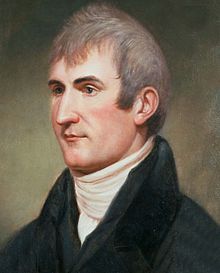There are enough suspects in the death of Meriwether Lewis-including the famous explorer himself-to fill an Agatha Christie mystery. How could the man who, with William Clark, was exalted for opening transcontinental passage to the Pacific Ocean wind up a few years later broke and dead on a well-traveled Eastern road? No one really knows, but theories abound. Upon Lewis’ triumphal return from his two-year expedition, President Thomas Jefferson, his friend and childhood neighbor, appointed him in 1807 governor of the upper Louisiana Territory. But Lewis was a better explorer than administrator. In office in St. Louis, he was plagued by unruly settlers, corrupt officials, and arduous negotiations with various Indian tribes. More and more distraught over his troubles by 1809, Lewis abruptly decided to go to Washington to try to straighten out some matters, including a dispute over unpaid expense reports that had left him in debt. In early September, Lewis left St. Louis on a boat for New Orleans, from where he would take ocean passage for Washington. During the river voyage, he made out his will, leaving whatever estate he had to his mother. He apparently suffered a breakdown, and a few days later, when the boat reached Chickasaw Bluffs, (now Memphis), Lewis was put ashore with a high fever and in a state of mental derangement. He had twice attempted to kill himself. The governor recuperated for a couple of weeks at Fort Pickering, then on September 29, after borrowing $100 to see him through his trip, left with two servants and an Army officer along the overland route called the Natchez Trace. What happened after that has been questioned by historians, but here is one version. On October 10, Lewis stopped for the night 72 miles southwest of Nashville in one of two log cabins owned by Mrs. Robert Grinder, whose husband was away. Mrs. Grinder said later that Lewis was clearly agitated. Well into the night he paced back and forth and mumbled, his muttering punctuated by occasional outbursts, about the unfairness of his problems in Washington. During the night, Mrs. Grinder said, she heard a gunshot followed by a thud in Lewis’ adjacent cabin. Then she heard him yell “Oh, Lord!,” then another shot. Lewis staggered to her cabin and pleaded through the door, “Oh, madam! Give me some water, and heal my wounds!” But Mrs. Grinder said she was too frightened to open the door. Only the next morning did she send one of her children out to the distant barn to alert Lewis’ servants, who apparently hadn’t heard the commotion. They found Lewis lying on his bed, shot once in his side and once in his head, alive but with part of his forehead shattered and his brain exposed. Lewis begged them to kill him. His last words were “I am no coward, but I am so strong. It is so hard to die.” Lewis was buried in a makeshift plank box near the cabin, alongside the Natchez Trace. All indications from that story are that Lewis committed suicide. That’s the version that made it to Washington and received the most attention. But local Tennesseeans believed otherwise. Speculation of foul play passed down through the generations, so that even on March 6, 1930, there was a headline in the Lewis County Herald that read: “Was Lewis Murdered?” Was he? There was never an investigation to find out. But historians have pointed to several plausible suspects. The Army officer who had been traveling with Lewis had been separated from the group for a couple of days. When he arrived later on the day Lewis died, he didn’t even examine Lewis’ wounds for gunpowder burns to determine whether he had been shot at extremely close range. Given the political backstabbing rampant in the Louisiana Territory, the officer himself could have killed Lewis. So could Lewis’ servants, who later complained that Lewis had never paid them enough. Lewis was found with only 25 cents on his body, although he had left Fort Pickering with more than $100. Also suspect is Mrs. Grinder, who may have been so spooked by Lewis that she decided to kill him. Some say Mr. Grinder returned during the night and killed Lewis while robbing him. In fact, there were highway robbers all over the Natchez Trace who could be held in suspicion. The verdict is forever suspended. Even the location of Lewis’ grave is unclear. It was poorly marked until a national monument was established on the site in 1925, well over a century after the mystery was played out.
Follow Me
© 2025 Chris Enss | Privacy Policy | Design by Winter Street Design Group | Login

